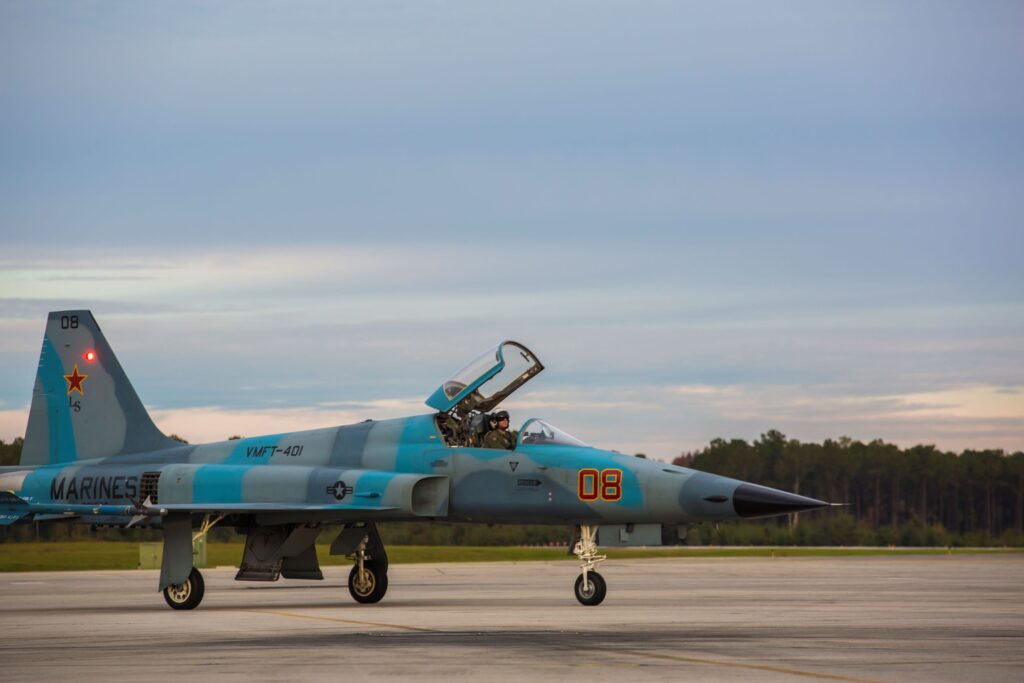
ARLINGTON, Va. — The Marine Corps plans to activate a second adversary aircraft squadron to meet the future aerial combat training needs of its fighter attack squadrons. The second squadron will provide the East Coast with similar training assets as the West Coast.
According to the 2022 Marine Corps Aviation Plan released this week, Marine Fighter Training Squadron 402 (VMFT-402) will be activated in fiscal 2023 at Marine Corps Air Station Beaufort, South Carolina, scheduled to be safe for flight by the beginning of 2024.
The Corps has long fielded reserve squadron VMFT-401 at MCAS Yuma, Arizona, which flies Northrop 11 single-seat F-5N and one F-5F Tiger II fighters. The squadron is upgrading to 11 F-5N+ and one F-5F+ aircraft.
VMFT-402, which also will be a reserve squadron initially, will be equipped with three F-5N+ aircraft but eventually will operate eight F-5N+ and two F-5F+ aircraft.
To equip the new squadron, the Marine Corps has acquired 11 additional F-5 aircraft from the Swiss air force through the Naval Air Systems Command. The aircraft will be delivered to the Corps over a four-year period beginning in the fourth quarter of 2023.
The Navy and Marine Corps F-5 fleet is going through upgrades to increase capabilities and extend the service life. The fleet is being upgraded with digital cockpits at a rate of two or three aircraft per year. The Naval Air Systems Command plans to integrate TCTS II Tactical Combat Training System – Increment II (TCTS II) to “allow synthetic adversary injects to decrease the forecasted gap in adversary training.”
“Serving as a training asset for the entire MAGTF, as well as the joint force, the F-5 has seen adversary requirements grow significantly over the past 13 years,” according to the aviation plan, in large part because of the pilot training requirements of the F-35 fleet replacement squadrons VMFA-501 and VMFA-502. “Annual fleet adversary requirements are expected to also increase for transitioning squadrons from 12,000 air-to-air sorties in [fiscal 2022 to 17,000 sorties per year in order to meet T2.0 requirements in [fiscal 2025].”
The aviation plan said that “Adversary capacity is the greatest issue in Marine Corps air-to-air training, followed closely by range availability and modernization, and training simulator capabilities. VMFT-401 can source up to 3,300 sorties per year, restrained by aircraft utilization and numbers of F-5s assigned. Combining A/A [air-to-air] requirements for fleet training, FRS [fleet replacement squadron] production and weapon school support, the USMC builds an adversary requirement of nearly 15,000 sorties in 2022. Accordingly, the USMC suffers over an 11,000-sortie capacity gap. Aviation is looking at options to close this gap.”
The U.S. military uses commercial air services which fly former military jets in the adversary role, but, according to the aviation plan, “commercial air services cannot satisfy all of the adversary requirements. The future lies in multiple solutions that include using the fleet of F-5s efficiently, exploring low-cost training opportunities, incorporating Live, Virtual, Constructive capability, and commercial air services to augment requirements.”
- SECNAV Advocates Increased Legal Immigration to Increase Shipbuilder Workforce - April 23, 2024
- Insitu Going Strong at 30, Focusing on Maritime Operations - April 8, 2024
- Navy Awards Boeing Additional Funds for MQ-25 Drones for Testing - April 3, 2024






